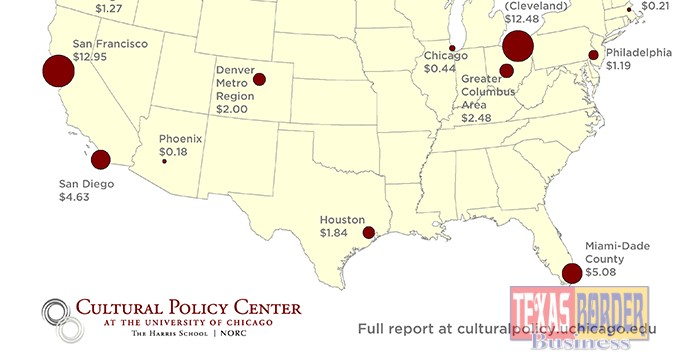
Texas Border Business—–Newswise — Local direct public funding provided through grants for the arts in Chicago is low compared to peer regions in both total dollar and per capita terms, according to a new report from the Cultural Policy Center at the University of Chicago.
The study tracks direct public funding for the arts in 13 regions from 2002-2012. It provides a nuanced look at how much money comes to the nonprofit arts from national, state and local arts agencies, with an emphasis on the important role of local arts agencies. While most studies of public funding for the arts use appropriations made on the national and state levels and estimates of local expenditures, this report draws exact dollar figures from grant-level data.
“There are a lot of different ways that city- or regional-arts agencies and departments are structured and funded and make grants,” explained Jennifer Novak-Leonard, a researcher at the Cultural Policy Center, who co-authored the report with research assistant Patience E. Baach. “This variation can make it challenging to learn from what is happening in other regions. Yet in light of recommendations in the Chicago Cultural Plan to increase public funding levels, to develop new mechanisms for doing that, and to align funding strategies with the operational realities of arts organizations, we felt an empirical look at Chicago and other regions was needed.” She added, “I’d like to thank all of the agencies that shared their data with us and helped us understand this information.”
In 2012, Chicago received $7.3 million in public dollars via competitive grants from local, state and national public arts agencies combined. That was more than all but three of the regions studied, but a substantial drop from the $16.5 million it received in 2002.
Chicago’s drop in funding was in large part due to the Illinois Arts Council’s budget being cut by more than half in 2010. Chicago received over half of its competitive arts grant dollars from that state agency, whereas of the 13 regions analyzed, eight received over half of the total competitive arts grant dollars from their local agency.
On the local level, the report does not consider programming put on by arts agencies themselves. For example, Chicago’s local arts agency, the Department of Cultural Affairs and Special Events (DCASE), funds and operates the Chicago Blues Festival, the Air and Water Show and many free events in Millennium Park and Grant Park. The study excludes these, considering only grants awarded to other organizations and artists.
By that measure, DCASE provides lower levels of funding than most of the local agencies studied. In 2012, DCASE awarded $1.2 million in grants, which is $0.44 per capita. That is less in both total dollar and per capita terms than Cuyahoga County (Cleveland, Ohio), Miami-Dade County, San Francisco, San Diego, the Denver Metro Region, Houston, the Greater Columbus Area, the Portland Metro Region and Philadelphia. The other cities in the study are Baltimore, Boston and Phoenix.
Despite its relatively low funding level, over the past decade DCASE annually awarded among the highest total number of grants compared with other regions’ local agencies, reaching almost a third of Chicago’s nonprofit arts organizations.
“The amount of public funding available as grants to arts organizations and artists is only one measure, but an important one, of what contributes to a city’s creative vitality,” said Betty Farrell, Executive Director of the Cultural Policy Center, which is a joint venture of the Harris School of Public Policy and NORC at the University of Chicago. “We believe the kind of comparative lens used in this research can help highlight both the current strengths and challenges of Chicago’s cultural sector.”

The study, which was supported in part by Arts Alliance Illinois, follows on the heels of a report released last month by the Cultural Policy Center about the size and structure of Chicago’s creative economy compared to peer cities, and one last week about how well Chicago retains its arts students after they graduate.














